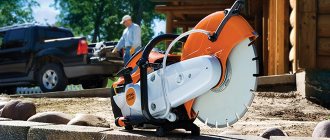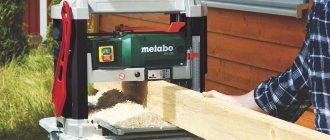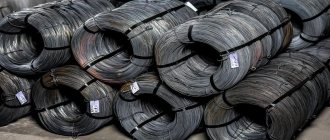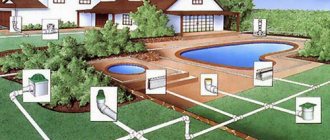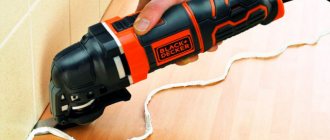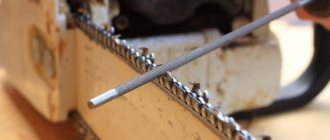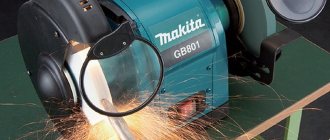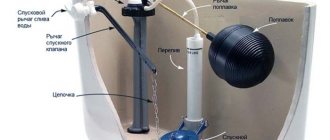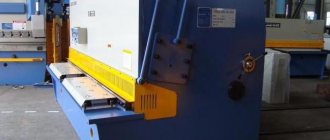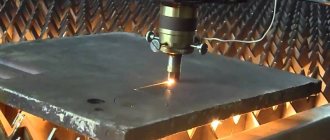The modern market offers a variety of tools that perform different functions. Many people are familiar with some types, but there are also completely incomprehensible devices. These include a gas cutter, which is often used by professionals during construction and repairs.
What is a petrol cutter?
The tool is a self-contained yet compact circular saw equipped with a special rotating disk with a cutting edge. A petrol cutter is a device that, unlike its close relative, is capable of cutting hard rocks and materials. Thanks to the high speed of rotation of the disk, the tool can cut various products of impressive thickness in a short period of time. The main advantage is the possibility of use where there is no electricity. Today, the market offers household, semi-professional and professional models.
Petrol cutter device
When purchasing such a tool, it is important to understand that this is the most massive equipment, so special transport carts will be needed to use it. Regardless of the model, the main elements of the device are:
- frame;
- engine;
- chain drive;
- coated disk;
- lever;
- protective casing.
The cost of the product is directly related to the quality and size of the disc. Petrol cutters for metal are divided into groups for wet and dry cutting. In the first version, the device is additionally equipped with a casing with liquid supplied through special tubes to the material being processed and the disk. The cost of this equipment is much higher than those that do not have it.
The principle of operation of a gas cutter
The engine runs on a mixture of gasoline and oil. After switching on, the disk begins to perform rotational movements, due to which the desired surface is cut. To understand how to work with a gas cutter, it is worth knowing the features of these manipulations:
- the cutting depth is limited by the diameter of the disk;
- It is recommended to use a small sector when cutting;
- The gas cutter must be held at right angles to the surface being worked on;
- special wheels are used to cut different materials;
- Diamond discs are consumables that quickly deteriorate.
Device
Cutting set
- Diamond segmental blades that can be selected for any hard material (concrete, reinforced concrete, brick, asphalt, etc.). There are rescue discs that cut any materials, incl. steel, rubber, etc.
- Diamond rings are a type of diamond blade. Due to the fact that the drive is carried out not through the shaft in the center of the disk, but through a pusher from the edge, the cutting depth increases by more than 2 times with the same diameter of the disk and ring.
- Cut-n-Break twin diamond blades are designed for applications that require deep cutting on a budget, such as cutting depths up to 400mm. This depth is achieved through a special gas cutter device. The double discs make a groove, highlighting a pier, which is subsequently removed using the supplied crowbar.
- Abrasive discs are used for cutting metal. The depth of cut is limited by the diameter of the disc and is usually equal to one third of the diameter.
- A diamond chain cuts all hard materials, but unlike a disk, it allows it to be done to a greater depth.
The cutting depth and size of the headset have an inter-industry standard: 300-500 mm for diamond and abrasive discs with a cutting depth in the range of 90 – 400 mm; 300-630 mm for chain.
Drive unit
The heart of the gas cutter is a high-torque motor, whose energy is transmitted to the shaft through a drive belt. This system makes the tool multifunctional, versatile and safe. The power of all engines does not differ much and is precisely matched to a specific disc diameter.
- A two-stroke engine running on a fuel mixture of gasoline and oil. This choice is due to the fact that this type of engine can operate in any spatial position; has low weight and dimensions; has sufficient power. There are special engines in which oil and gasoline are poured separately, and the mixture is “prepared” by the engine itself.
- Electric motor operating from a 220 or 380 Volt network. Its use is due to the fact that some of the work is carried out indoors, where the presence of exhaust gases is not permissible.
- The battery drive is currently available for models with disks with a diameter of 230 mm, but it is not replaceable when working in collectors far from the electrical network.
- The pneumatic motor is powered by a compressor and, compared to the two previous types, has a significantly longer service life due to its design features.
The engine rests on the frame through shock-absorbing pads to dampen vibration. For the same purpose, the control handles have soft pads.
Cutting type
- Wet. The protective casing has a system for wetting the disk with water, which is supplied from an external source through a connector. The disk is cooled by a flow of water, which prevents rapid overheating of the equipment. Thanks to the presence of liquid, the problem of dust is also solved. Therefore, this type of cutting is safer for health and extends the service life of diamond blades.
- Dry. The disk is cooled only by air flow and heats up quickly. If the abrasive disc takes such a load calmly, then when working with a diamond tool it is better to work continuously for no more than a minute, after which the disc needs to be given about 15-30 seconds to cool.
Systems that improve and facilitate work with a gas cutter
- An easy engine starting system, for example, ElastoStart from Stihl, which allows you to start the engine with half a turn.
- Husqvarna's X-Torq technology equips the engine with two intake ports and each now separately admits the fuel mixture and air, which increases power, reduces fuel consumption by 25% and reduces emissions of harmful substances by 75%.
- A double or triple air filtration system through special air filters protects the engine from dust, especially during dry cutting.
- Possibility of installation on a trolley kit and creation of a joint cutter.
- Diamond blade guards prevent excessive dust formation and protect the operator.
- A special attachment for attaching to a rail and its subsequent cutting allows us to distinguish another type of tool - a rail cutter.
What is better: a gas cutter or a gas cutter?
You can compare tools for working with metal. You can understand which option is better by becoming familiar with the basic operating parameters of these devices. Let's look at the most important ones:
- The petrol cutter cuts the material due to the rotation of the disk. Gas cutting results in the combustion of metal in a stream of pure oxygen.
- Some types of products cannot be separated using a gas cutter; with a gas cutter, only thickness can become a problem.
- In terms of weight, a gas-powered device wins, because the operator only has to hold the burner itself, which, due to its size, weighs little. The cylinder is on the floor.
- For safety reasons, it is better to deal with a gas cutter. If you follow the operating rules, no problems should arise. Working with gas requires some special features regarding the placement of the cylinder and working conditions. In addition, interaction with gas is carried out with a welder’s mask.
Petrol cutter - getting to know the tool
Externally, this tool, which is often called a wall saw or kerosene cutter, is similar to a circular saw, because its main working part is a disk with a sharply sharpened edge. Moreover, the disk for a gas cutter has a fairly large diameter, which allows you to get quite deep into the surface being processed (the cut can reach 40 cm). The main difference from a circular saw is the hardness of the material that we can cut using this device.
A conventional saw is designed, as a rule, for wood and its derivatives, that is, chipboards, plywood and other soft surfaces. Our tool will withstand much greater testing and copes well with metal, concrete, natural stone, asphalt and similar “hard materials”. Without any problems, you can cut pipes, steel beams, bricks, composite materials, or cut an opening in the wall. Grilling is not complete without such a useful device.
The thickness of the products that can be obtained depends on how fragile and hard the material is, not everything can be cut thin. This should probably be taken into account when planning work.
Work with a gas cutter can be carried out anywhere, even where there is no access to a power source, because from the name it is clear that this tool is powered by fuel, which is so familiar to our cars. He himself is quite compact, despite the strength he carries. The price is quite high, so this equipment can most often be found in service with professional construction teams or large companies for the repair of roads and communications.
Types of gas cutters
Depending on the properties of the material being processed, tools fall into the following categories:
- For metal
. Power up to 4.2 kW. - On concrete
. Power more than 4.2 kW. The chain cutter for concrete has a disk rotation speed of 4.7 thousand revolutions/min. - Universal models
. The tools are endowed with the highest performance, as they are designed to work with different types.
In addition, there is a division according to purpose into:
- Rail cutters
- there is a mechanism that significantly expands the depth of cut. Used by railway line installers. - Wall chaser
– works with two diamond-coated discs. Used to create grooves for electrical wiring in various surfaces. - Chain cutter
- the tool looks like a gasoline saw; a diamond chain allows you to cut both metal and stone. - Chrome-plated gas cutters
- used for rescue operations.
Design and principle of operation of a gas cutter
The main component of a gas cutting tool is an engine, mainly a 2-stroke engine, which runs on a fuel mixture of oil and gasoline. The unit is mounted on a housing equipped with special handles and controls. The functional part of the gas cutter is the drive, on which a cutting disc with a diameter of 300-400 mm, protected by a casing, is installed. The transmission of torque from the engine to the drive is carried out via a belt.
The main feature of modern gas cutters is the presence of a multi-stage dust protection system. It prevents contamination of the carburetor, cylinder-piston group and bearings. In addition, dry cutting uses water cooling of the disc. It effectively neutralizes the main flow of dust and prevents a number of negative consequences of overheating, in particular, premature wear of the cutting element and destruction of its structure, and also reduces the load on the engine.
When working with a gas cutter, it is necessary to maintain a right angle between the cutting disc and the surface being processed. This reduces the load on the drive and prevents slippage from the cutting line and damage to the cutting edge. The maximum insertion depth of the disk for various models is in the range of 10-30 cm. When cutting dry materials, you should not use a gas cutter for more than 30-50 seconds - within 15-20 seconds after making the cut, it is necessary to ensure free rotation of the disk.
Powerful models weighing more than 15 kg are equipped with transport trolleys with a remote control system or special legs, which allow the tool to be firmly fixed when cutting.
Characteristics of gas cutters
The modern market offers a wide selection of different models. According to consumer reviews, the greatest demand is for semi-professional options that cost less and perform multiple tasks. This type of autonomous circular saw has the following characteristics:
- tool design;
- equipment power – on average 3-3.5 kW;
- cutting height – approximately 125 mm;
- disc diameter – about 350 mm;
- diameter of the mounting hole is on average 20 mm;
- engine volume – on average 65-75 cm³;
- tank capacity – approximately 0.65-0.7 l;
- noise level – approximately 95-100 dB;
- instrument weight – about 9.5-12 kg;
- additional functions.
Disc for gas cutter
The division is carried out according to several criteria. Depending on the material that needs to be cut, discs come in the following types:
- For metal
. For working with different products and workpieces. - On wood
. The disc has sharp teeth located along the entire edge. - By stone
. There is diamond coating on the edge of the disc. - On concrete
. Presence of thick diamond coating. - For reinforced concrete
. Used where reinforcement is present.
In addition, the division occurs based on the appearance of the disk:
- Turbo disk
. A universal option for any type of cutting. Wave-shaped edge with slanted grooves. By reducing the thickness of the circle on the gas cutter, natural cooling of the disc occurs. - Solid
. Solid version with continuous diamond edge. Carry out wet cutting. - Segmented
. The edge has slots that help cool the blade during operation. Used for dry cutting.
Rating of petrol cutters
To make the right choice, it is recommended to first get acquainted with the models that are very popular. The best gas cutter should be chosen from the following list:
- Stihl TS 420
. Low vibration and comfortable handle shape allows you to work in any position. - Husqvarna K 760
. The petrol cutter quickly copes with the assigned tasks in the most emergency situations. - Makita DPC 6431
. Reinforced aluminum casing for low vibration. - Partner K 750
. The body of the model is shortened, which helps control the process. - Hilti DSH 900-X
. It has a powerful motor, reinforced with a protective casing. - Hitachi CM75EAP
. The cheapest tool. Suitable for cutting metal. - Echo CSG-680
. Manual petrol cutter with automatic ignition advance system. - Wacker Neuson BTS 635
S. A simple device with a durable body and good dust and moisture protection. - Oleo-Mac 983TTA-14
. Suitable for semi-professional use. - Solo 881-14
. The advantage is its lightness and good weight distribution. Technically complex device.
Do-it-yourself petrol cutter
To save money, craftsmen can try to assemble the instrument themselves from available materials. A petrol cutter for asphalt or other material is made from the following items:
- chainsaw;
- grinder head assembly;
- tires;
- pulleys;
- belt.
The design of a gas cutter is as follows:
- The belt is located along the axis of the tire.
- The pulley is fixed to the sprocket.
- The gear in the grinder assembly has been removed. It is machined and a pulley is made to fit its dimensions, which is welded.
- The tires are shortened and welded.
- The attachment is removable and, if necessary, the chainsaw can be used for its intended purpose.
How to use a gas cutter?
The first thing you need to know when working with a special-purpose tool is compliance with safety precautions. It is important to use the following protection measures:
- glasses and mask;
- headphones;
- helmet;
- clothes made of thick fabric;
- closed shoes and gloves.
It is important to first check the instrument for possible damage. The correct procedure for starting a gas cutter is as follows:
- the instrument is placed on a flat surface;
- the lever is moved to the working area;
- open the air damper;
- start the engine with a sharp movement of the starter handle;
- close the air damper halfway to idle;
- release the shutter lever and press the start button.
Rules for working with a gas cutter
For high-quality and safe use, it is important to adhere to the following recommendations:
- When performing dry cutting, care must be taken to ensure that the blade does not overheat. Costs every 2 minutes. make a stop.
- A complete and compact circular saw must have a protective cover.
- It is important to remember that the gas cutter is designed for straight cutting only.
- The edge of the saw blade should smoothly touch the work material. Movements should not be sudden or with strong pressure.
- Work begins after the tool has reached the required speed.
- The cuts are not made deep to prevent pinching of the disc.
- It is prohibited to grind products with a working disc. This will lead to cracks and destruction of the cutting edge.
- The correct position of the gas cutter is on top of the work surface.
Starting the gas cutter and troubleshooting possible problems
To start a gas cutter, proceed as follows:
- place the instrument on a level place, for example, on the floor;
- with the left hand they grasp the front handle, and with the right foot they step on the back handle, pressing it against the supporting surface;
- with your right hand, pull the starter slowly for the first time until there is noticeable resistance, so that the cable is extended by 1/2, maximum 2/3 of its length;
- then pull the starter handle in a straight line several times in short, quick jerks until the engine starts.
During startup, you must carefully monitor the disc or chain so that it does not come into contact with the surface on which the power tool is lying.
It should be taken into account that the starter handle should not quickly bounce back to the unit body, and the cable should not come out all the way (so as not to break).
If the model you are using is not equipped with an electronic system that regulates its warm and cold starts automatically, then all operations will need to be carried out manually.
Starting a cold engine is done as follows:
- the air damper is pulled out all the way;
- the ignition is set to working position;
- block the throttle valve by holding the lock button;
- pressing the trigger of this damper, hold it;
- the starter starts the engine;
- use the throttle trigger to regulate (having previously unlocked it) the engine speed during operation.
It is not recommended to cut materials with the damper fully open. It should be partially covered. It is recommended to start a warm engine (not yet cooled down after work) without using the air damper. If this does not work, then you will need to use it, as with a cold start.
It happens that the engine does not start at all or starts with significant difficulties. Possible causes of problems and ways to resolve them are presented in the table below.
| Causes of the problem | Remedy |
| Ignition switch is not turned on | it is necessary to switch it to the working position |
| the fuel mixture has run out or is of poor quality or water has entered | you should fill in new fuel, pouring out the old (if any) |
| fuel filter clogged | you need to replace it with a clean one and wash the fuel supply hoses and tank |
| The spark plug is faulty or dirty | you need to install a new one or clean the old one by adjusting the distance between the electrodes |
| Magneto or wiring fault | It is recommended to contact a service center |
| the engine is full of fuel | it is necessary to crank the engine manually, with the spark plug unscrewed, which will need to be dried |
| air filter clogged | you can try to clean it or install a new one |
| carburetor adjustment is out of order | needs to be configured again |
| There is insufficient air supplied to the engine | damper needs to be adjusted |
After starting, the engine must be allowed to run for some time until its operating temperature is reached.
